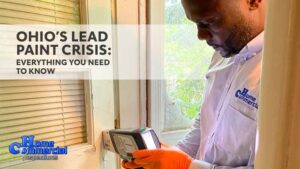


Pre-Listing Inspections in Ohio: Ensure a Smooth Sale Process
April 8, 2024


Understanding the Importance of Asbestos Inspections and Survey Reports Essential Insights for Property Buyers
May 13, 2024Ohio’s Lead Paint Crisis: Everything You Need to Know

Ohio is in a lead paint crisis, with much of the region’s housing built before 1978 when the toxic metal was still commonly used in paint, posing serious health risks to children and adults.
An estimated 67% of all housing across Ohio were built using the poisonous paint before it was banned.
In December last year, Ohio state authorities, led by Governor Mike DeWine, unveiled an $84 million initiative aimed at safeguarding residents from lead hazards.
The money is being allocated to all 88 counties, with $50.3 million for owner-occupied homes, $17.3 million for rental properties, $6.5 million for childcare facilities, and $1.5 million for care shelters.
To help battle this crisis, Home & Commercial Inspections is performing comprehensive, professional inspections for toxic lead in Columbus, Cincinnati, and Dayton.
Health Consequences of Lead Poisoning
Lead-based paint was widely used in homes because of its durability and color retention properties.
But as lead paint deteriorates over time, it can create lead dust and flakes that can be ingested or inhaled, posing serious health risks, especially to children and pregnant women.
There is currently no known safe blood lead value.
According to the World Health Organization, the neurological and behavioral effects of lead are believed to be permanent. Blood lead concentrations as low as 3.5 µg/dL have been linked to behavioral issues, learning difficulties, and reduced intellect in children.
The Lead Safe Cleveland Coalition reports that during pregnancy, lead in the mother’s bone can be released into the bloodstream and expose an unborn child to the toxin. Lead can also pass through the placental barrier and cause miscarriage, congenital deformities, slowed fetal growth, early birth, stillbirth, and low birth weight.
Why Are Lead Paint Inspections Necessary?
Lead paint inspections are crucial for ensuring the safety of homes, especially in Ohio’s older homes that may contain lead-based paint.
Lead exposure can cause severe health issues, affecting the brain, heart, bones, kidneys, and nervous system, causing:
- Developmental delays
- Learning disabilities
- Behavioral problems, particularly in children
Signs and Symptoms of Lead Poisoning in Children:
The Cleveland Clinic says children with lead poisoning may show no symptoms. “Even healthy-looking children can have high levels of lead in their bodies.”
Symptoms can include:
- Cramps
- Hyperactivity
- Learning problems
- Changes in behavior
- Headaches
- Vomiting
- Fatigue
- Anemia
Signs and Symptoms of Lead Poisoning in Adults:
Symptoms in adults may include:
- Headaches
- Abdominal pain
- Personality changes
- Anemia
- Numbness in feet and legs
- Loss of sex drive
- Infertility
Lead Paint Inspection Process with Home & Commercial Inspections
Our lead paint inspection process in Columbus, Cincinnati, and Dayton involves a certified inspector examining various surfaces in the home for the presence of lead-based paint. This typically includes testing painted surfaces, such as walls, windows, doors, and trim. Inspectors may also collect dust and soil samples for analysis.
Legal Requirements for Lead Paint Inspections in Ohio
In Ohio, there are specific regulations governing lead paint inspections, especially in rental properties and childcare facilities.
In order to maintain the property in good repair, Ohio law requires landlords to remove lead risks and abide by lead abatement orders when they are issued. Additionally, while renovating or doing repairs on rental buildings, they must follow lead-safe procedures.
Failure to comply with these regulations can result in fines and legal consequences, so it’s essential for homeowners and landlords to understand their obligations regarding lead-based paint inspections.
DIY Lead Paint Testing vs. Professional Inspections
While DIY lead-paint testing kits are available, they may not always provide accurate results. Professional lead-based paint inspectors have the expertise and specialized equipment to conduct thorough inspections and accurately identify lead hazards in homes.
How to Prepare for a Lead Paint Inspection
Before a lead paint inspection:
- Remove clutter and ensure access to all painted surfaces.
- Keep pets and children away from the inspection area to prevent potential exposure to lead dust.
Understanding Lead Paint Inspection Reports
Following a lead paint inspection, we will provide a detailed report outlining the findings and any recommended actions. Take time to understand the report so you can promptly address any identified lead hazards.
Addressing Lead Paint Hazards
If lead hazards are identified during an inspection, you must take steps to mitigate the risks. To safely contain or remove lead paint from the home, this may involve:
- Lead paint abatement. This has a maximum 20-year lifespan and involves either replacing or removing structures (e.g., windows and doors) or covering major surfaces (e.g., walls, ceilings, and exposed soil).
- Encapsulating affected areas using specialized sealants.
Other Sources of Lead-Based Paint
While lead-based paint and lead-contaminated dust in older buildings are the most common form of lead exposure, lead can also be found in:
- Soil
- Jewelry
- Toys
- Home remedies
- Ceramics
- Candy
- Water
Protect Your Family with Home & Commercial Inspections
Lead paint inspections are essential for safeguarding the health and well-being of occupants, particularly in older homes where lead-based paint may be present.
By understanding the importance of lead paint inspections and complying with legal requirements, homeowners can create a safer living environment for themselves and their families.
Call 1-800-241-0133 to schedule a home lead inspection in Columbus, Cincinnati, and Dayton!
FAQs:
What are the common sources of lead exposure in homes?
Lead exposure can occur through various sources, including lead-based paint, contaminated soil, lead pipes, and certain consumer products.
How often should lead paint inspections be conducted?
Lead paint inspections should be conducted before purchasing or renting a home built before 1978. Additionally, periodic inspections may be necessary, especially if there are renovations or deteriorating paint surfaces.
Can lead paint be safely encapsulated rather than removed?
Yes, lead paint can be encapsulated using specialized sealants to prevent lead dust from being released into the environment. However, encapsulation may not be suitable for all situations and should be evaluated by a qualified professional.
What should I do if my home contains lead paint?
If lead paint is present in your home, it’s essential to take steps to minimize exposure, such as keeping painted surfaces in good condition and addressing any peeling or chipping paint promptly. Consulting with a Home & Commercial Inspections certified lead paint professional can help determine the best course of action.
Are there any financial assistance programs for lead paint abatement?
Yes, there are various financial assistance programs available to help homeowners and landlords with the cost of lead paint abatement. These may include grants, loans, or tax credits provided by local, state, or federal agencies.
Don’t wait to test your property—the risks are too great.
Call 1-800-241-0133 to schedule a home lead inspection in Columbus, Cincinnati, and Dayton!

